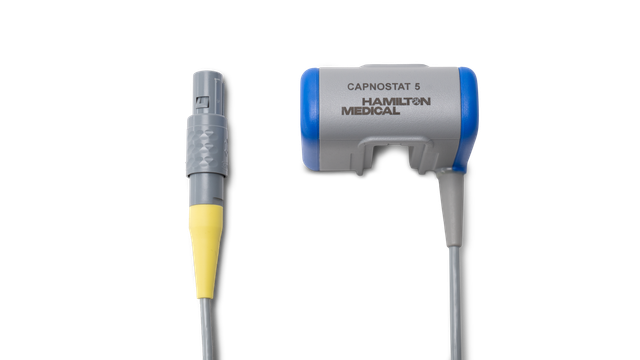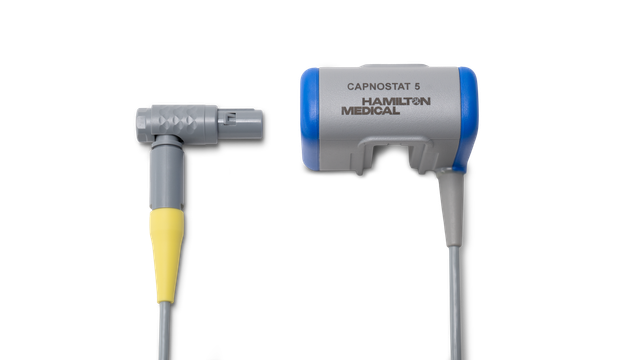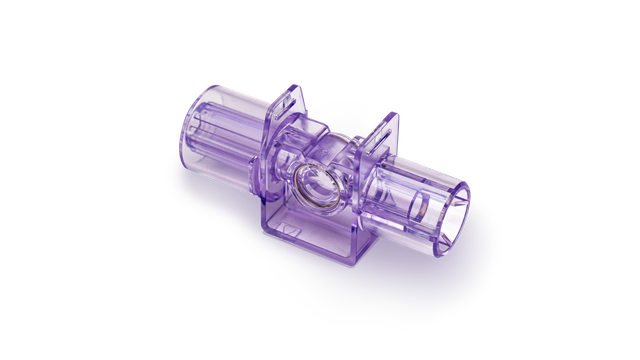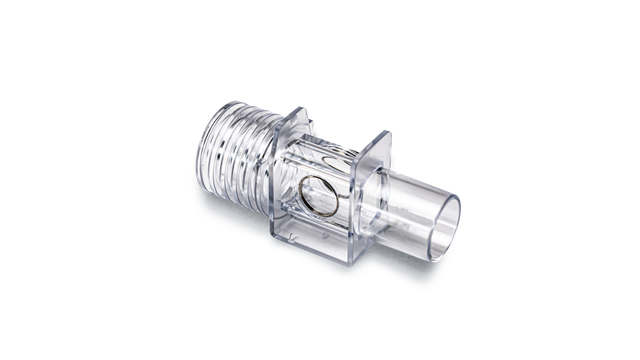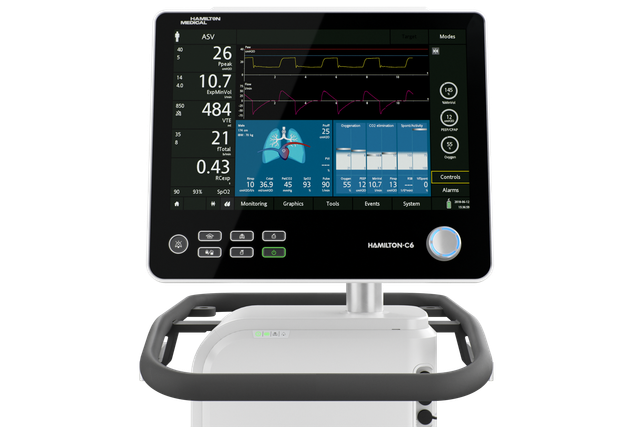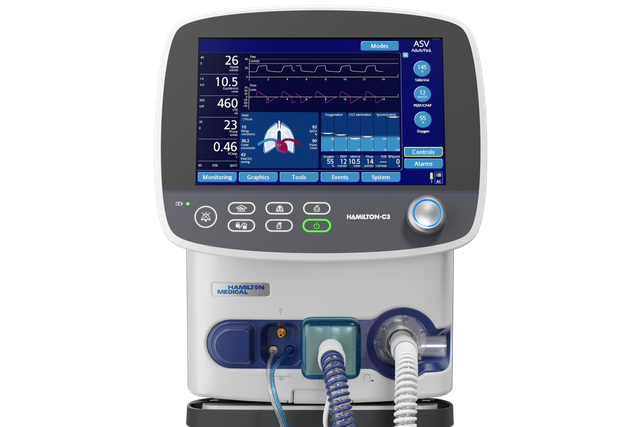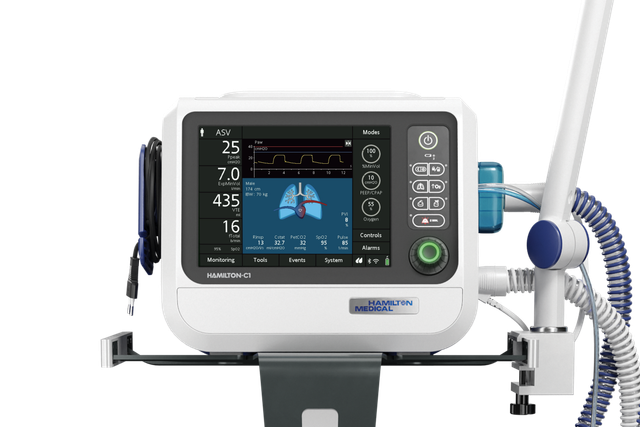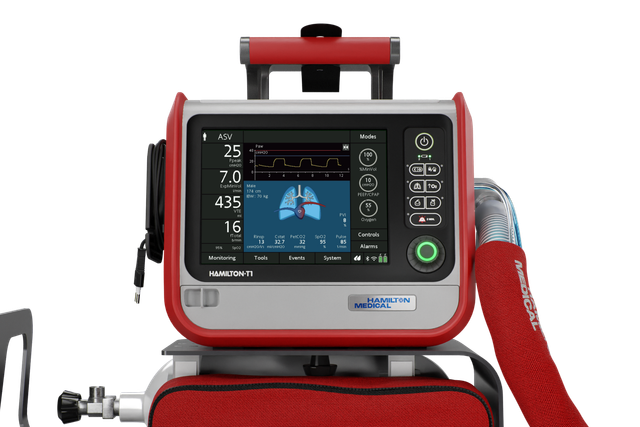
For more insights. Volumetric CO2 monitoring
A volumetric capnogram's phases, shape and curve morphology, and calculation derived measurements, can tell you an important story about:
- Ventilation‑perfusion efficiency
- Physiologic dead‑space fraction
- Patient's metabolic rate (
Jaffe MB. Using the features of the time and volumetric capnogram for classification and prediction. J Clin Monit Comput. 2017;31(1):19‑41. doi:10.1007/s10877‑016‑9830‑z1 )
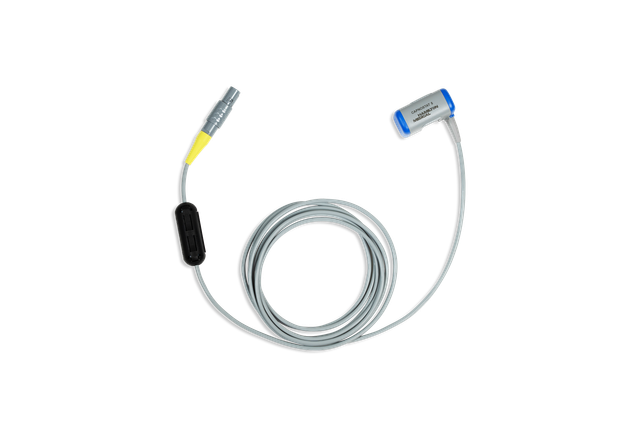
A powerful tool. The CO2 sensor
On our ventilators, CO2 is measured with a CAPNOSTAT‑5 mainstream CO2 sensor proximal to the patient's airway.
The CAPNOSTAT‑5 sensor gives you precise measurements of end‑tidal carbon dioxide (PetCO2), and a clear, accurate capnogram at all respiratory rates of up to 150 breaths per minute.
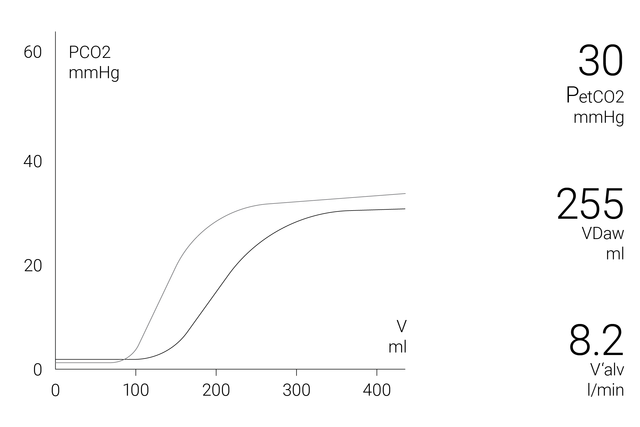
Little sensor, big data. This is what you get
The volumetric capnogram window on the display shows exact quantitative information as a combination of proximal flow and proximal CO2 data such as:
- Current volumetric capnogram curve
- Volumetric capnogram reference curve
- Reference curve button with time and date of reference loop
- Most relevant CO2 values, breath by breath
To allow a more comprehensive analysis of the patient condition, a 72‑hour trend (or 96‑hour with HAMILTON‑G5/S1) is available for:
- PetCO2
- V‘CO2
- FetCO2
- VeCO2
- ViCO2
- Vtalv
- V'alv
- VDaw
- VD/Vt
- VDaw/VTE
- Slope CO2
To make your life easier, Hamilton Medical ventilators offer an overview of all relevant CO2‑related values in the Monitoring CO2 window.
- Fractional end‑tidal CO2 concentration: FetCO2 (%)
- End‑tidal CO2 pressure: PetCO2 (mmHg)
- Slope of the alveolar plateau on the PetCO2 curve, indicating the volume/flow status of the lungs: slopeCO2 (%CO2/l)
- Alveolar tidal ventilation: Vtalv (ml)
- Alveolar minute ventilation: V’alv (l/min)
- CO2 elimination: V’CO2 (ml/min)
- Airway dead space: VDaw (ml)
- Airway dead‑space fraction at the airway opening: VDaw/VTE (%)
- Exhaled CO2 volume: VeCO2 (ml)
- Inspired CO2 volume: ViCO2 (ml)
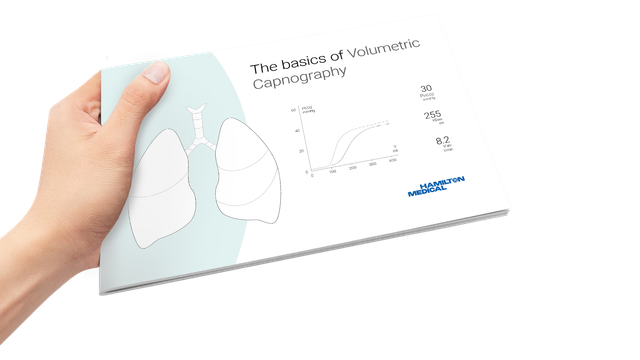
Free e‑book
Good to know! All about volumetric capnography
Learn how to interpret a volumetric capnogram and get an overview of the benefits and clinical applications of volumetric capnography. Includes a self‑test!
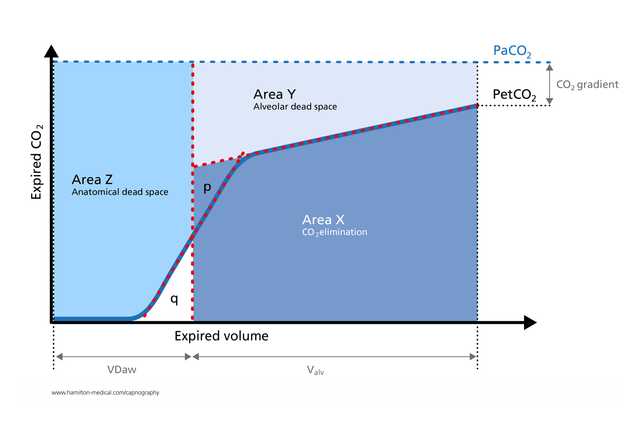
What are the benefits? A look at the evidence
The volumetric capnogram has been used successfully to measure anatomical dead space, pulmonary capillary perfusion, and ventilatory efficiency (
Romero PV, Lucangelo U, Lopez Aguilar J, Fernandez R, Blanch L. Physiologically based indices of volumetric capnography in patients receiving mechanical ventilation. Eur Respir J. 1997;10(6):1309‑1315. doi:10.1183/09031936.97.100613092 )Calculations derived from volumetric capnography are useful for identifying pulmonary embolism at the bedside (
Blanch L, Romero PV, Lucangelo U. Volumetric capnography in the mechanically ventilated patient. Minerva Anestesiol. 2006;72(6):577‑585. 3 )In a study of mechanically ventilated ARDS patients, volumetric capnography measurements of physiologic dead‑space‑to‑tidal‑volume ratio were as accurate as those obtained by metabolic monitor technique (
Kallet RH, Daniel BM, Garcia O, Matthay MA. Accuracy of physiologic dead space measurements in patients with acute respiratory distress syndrome using volumetric capnography: comparison with the metabolic monitor method. Respir Care. 2005;50(4):462‑467. 4 )The expiratory capnogram is an effort‑independent, rapid, and noninvasive measurement that can help detect significant bronchospasms in adult patients with asthma (
Yaron M, Padyk P, Hutsinpiller M, Cairns CB. Utility of the expiratory capnogram in the assessment of bronchospasm. Ann Emerg Med. 1996;28(4):403‑407. doi:10.1016/s0196‑0644(96)70005‑75 )By providing valuable real‑time insights into the physiology of lung collapse and recruitment in a noninvasive manner, volumetric capnography lends itself to monitoring cyclical recruitment maneuvers at the bedside (
Tusman G, Suarez-Sipmann F, Böhm SH, et al. Monitoring dead space during recruitment and PEEP titration in an experimental model. Intensive Care Med. 2006;32(11):1863-1871. doi:10.1007/s00134-006-0371-76 )

Good to know! Volumetric capnography training resources
Accessories and consumables
We offer original consumables for adult, pediatric, and neonatal patients. You can choose between reusable and single‑use products, according to your institutional policies.
Availability
Volumetric capnography is available as an option on the HAMILTON‑C6, the HAMILTON‑G5, the HAMILTON‑C3, and the HAMILTON‑C1/T1, and as a standard feature on the HAMILTON‑S1.
References
- 1. Jaffe MB. Using the features of the time and volumetric capnogram for classification and prediction. J Clin Monit Comput. 2017;31(1):19‑41. doi:10.1007/s10877‑016‑9830‑z
- 2. Romero PV, Lucangelo U, Lopez Aguilar J, Fernandez R, Blanch L. Physiologically based indices of volumetric capnography in patients receiving mechanical ventilation. Eur Respir J. 1997;10(6):1309‑1315. doi:10.1183/09031936.97.10061309
- 3. Blanch L, Romero PV, Lucangelo U. Volumetric capnography in the mechanically ventilated patient. Minerva Anestesiol. 2006;72(6):577‑585.
- 4. Kallet RH, Daniel BM, Garcia O, Matthay MA. Accuracy of physiologic dead space measurements in patients with acute respiratory distress syndrome using volumetric capnography: comparison with the metabolic monitor method. Respir Care. 2005;50(4):462‑467.
- 5. Yaron M, Padyk P, Hutsinpiller M, Cairns CB. Utility of the expiratory capnogram in the assessment of bronchospasm. Ann Emerg Med. 1996;28(4):403‑407. doi:10.1016/s0196‑0644(96)70005‑7
- 6. Tusman G, Suarez‑Sipmann F, Böhm SH, et al. Monitoring dead space during recruitment and PEEP titration in an experimental model. Intensive Care Med. 2006;32(11):1863‑1871. doi:10.1007/s00134‑006‑0371‑7


